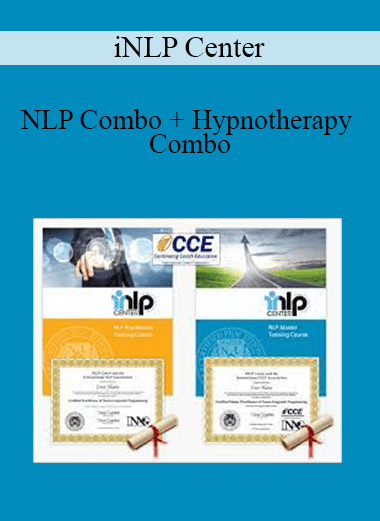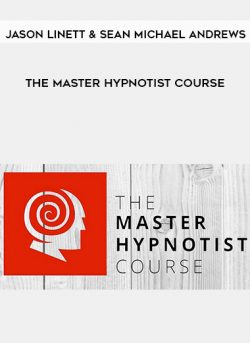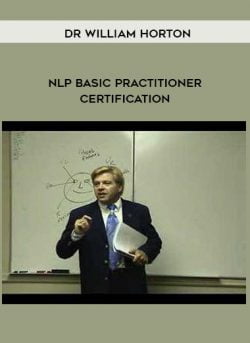iNLP Center – NLP Combo + Hypnotherapy Combo
Original price was: $1,529.00.$305.00Current price is: $305.00.
Product Delivery – You will receive Content Access Via Email.
Email – [email protected]
Description
NLP Combo + Hypnotherapy Combo
Courses Included:
• Hypnosis Practitioner Level 1
• Adv. Hypnotherapy
• NLP Practitioner
• NLP Master
• Bonus: Personal Development Program
Hypnosis Practitioner Level 1 Training
In our Hypnosis Practitioner Training course, you can expect to learn the fundamental hypnosis skills such as hypnotic voice, suggestibility, inductions, and deepeners, as well as learning the presenting problem protocol to assist you with your hypnosis session. Successful completion of this training qualifies you to hold the title of Certified Hypnosis Practitioner.
Understand what’s crucial to become a successful hypnotherapist.
This module gives you the hypnotherapy training foundation you need to begin to build your success and wrap your head around the concepts you’re about to learn.
|
Module 1
|
Introduction to Hypnosis
|
|
Unit 1
|
Live Session Requirements
|
|
Unit 2
|
Hypnosis Classroom Link
|
|
Unit 3
|
Introduction to Hypnosis
|
|
Unit 4
|
Hypnosis Theories
|
|
Unit 5
|
Levels of Trance
|
|
Unit 6
|
• Assignment: Levels of Trance
|
|
Unit 7
|
The Unconscious Mind
|
|
Unit 8
|
Facts of the Unconscious Mind
|
|
Unit 9
|
• Assignment: Unconscious Mind
|
|
Unit 10
|
Conscious/Unconscious Conflict
|
|
Unit 11
|
• Assignment: Conscious/Unconscious Conflict
|
Learn where hypnosis got its start & it’s common myths.
See how hypnosis has evolved, the challenges it’s faced, and what practices are still in use today. This module helps to educate you so you can educate your client. An educated client is a successful client.
Learn the truth about hypnosis in this module. You’ll also learn about what hypnosis can do and what it cannot do. This is great information for helping out those skeptical clients and questioning family members! Understanding these common hypnosis myths is mission-critical to our client’s success.
|
Module 2
|
The History of Hypnosis
|
|
Unit 1
|
Hypnosis in Ancient Times
|
|
Unit 2
|
Hypnosis in Modern Times
|
|
Unit 3
|
Hypnosis in the 20th Century
|
|
Unit 4
|
• Assignment: History of Hypnosis
|
|
Unit 5
|
Hypnosis Myths
|
|
Unit 6
|
• Assignment: Myths
|
Develop a Hypnotic Voice
Learn what to do to help someone achieve the hypnotic state. Discover how the subconscious mind reacts to tone, pitch, speed and banter. Master this skill with the content in this module and the rest will write itself.
|
Module 3
|
Hypnotic Voice
|
|
Unit 1
|
The Elements Involved in Voice
|
Breakdown the Structure of a Session.
Seeing all the pieces come together will help paint the picture on just how critical each piece is. Consider what you know about hypnosis to be the edges of a vast jigsaw puzzle. This module will actually show you what the puzzle looks like, so you can put the rest of the pieces together.
|
Module 4
|
Introduction to a Hypnosis Session
|
|
Unit 1
|
The Session Overview
|
|
Unit 2
|
• Assignment : The Session
|
Get to know your client.
Learn to build genuine rapport, following the client, educating the client, eliciting their true presenting problem and writing their goals will become natural for you with our Presenting Problem Worksheet. You will not find this hypnotherapy training and coaching tool anywhere else. It makes it easy to coach and discover the information to create real change for your client.
|
Module 5
|
Pre-Induction
|
|
Unit 1
|
The Purpose of a Pre-Induction
|
|
Unit 2
|
Rapport Building & Real Reflection
|
|
Unit 3
|
• Assignment: Pre-Induction
|
|
Unit 4
|
The Pre-Induction Model
|
|
Unit 5
|
Presenting Problem Breakdown
|
|
Unit 6
|
Related Feelings
|
|
Unit 7
|
Involved Behaviors
|
|
Unit 8
|
Triggers
|
|
Unit 9
|
Presenting Problem Demonstration
|
|
Unit 10
|
Creating Goals
|
|
Unit 11
|
How to Form Goals
|
|
Unit 12
|
• Assignment: Presenting Problem
|
Understand the subconscious mind and how to work with it.
This module teaches you the ins and outs of the subconscious mind and how to work with it. Learn how to address it, the language patterns it prefers and how to incorporate that into your client’s needs. Detailed instructions as well as scripts for inductions are provided for you here in this module.
|
Module 6
|
Inductions
|
|
Unit 1
|
Determining Suggestibility
|
|
Unit 2
|
Suggestibility Tests
|
|
Unit 3
|
Purpose of Suggestibility Tests
|
|
Unit 4
|
• Assignment: Suggestibility Tests
|
|
Unit 5
|
Induction Overview
|
|
Unit 6
|
Induction Types
|
|
Unit 7
|
• Assignment: Induction
|
In this module, you’ll learn not only how to perform a deepener, but you’ll learn it’s importance, how to structure one, how the subconscious mind reacts to it, and how to write one based on your clients preferred modalities.
|
Module 7
|
Deepeners
|
|
Unit 1
|
Deepeners Overview
|
|
Unit 2
|
Types of Deepeners
|
|
Unit 3
|
• Assignment: Deepeners
|
This is the Climax of a Session.
It’s where a client gets what they came for…a shift, a change, a completely new perspective. In this module, you’ll learn how to take a client’s goal and turn it into a suggestion that the subconscious mind will accept as reality. This is where all your training and all the time spent with the client up to this point will come into play. Learn how to utilize that time to create suggestions that are so powerful the client surpasses their goals.
|
Module 8
|
Post-Hypnotic Suggestions
|
|
Unit 1
|
Post-Hypnotic Suggestions Overview
|
|
Unit 2
|
Types of Suggestions
|
|
Unit 3
|
Delivering Post-Hypnotic Suggestions
|
|
Unit 4
|
Creating Post-Hypnotic Suggestions
|
|
Unit 5
|
• Assignment: Post-Hypnotic Suggestions
|
|
Unit 6
|
Intervention Scripts
|
|
Unit 7
|
• Assignment: Custom Intervention Scripts
|
How to Wrap Up Your Session.
Learn the language style that is needed to help solidify a successful session. You’ll learn and understand the importance of positivity at this point of the session and why it’s so critical. You’ll learn how to structure the discussion after the hypnotic session is over. Discover how to handle questions and how to move onto the next step.
|
Module 9
|
Awakening & Post-Talk
|
|
Unit 1
|
Awakening Overview
|
|
Unit 2
|
Awakening Information
|
|
Unit 3
|
Post-Talk Overview
|
|
Unit 4
|
Elements of Post-Talk
|
Ethics are critical at every point of client interaction.
To bring more credibility to the field, we rely on each other to adhere to a high level of ethics. In this module, you’ll learn what the general ethics are, scope of practice, as well as being provided a sample of a Clients Bill of Rights to use yourself.
|
Module 10
|
Ethics
|
|
Unit 1
|
General Ethical Principles
|
|
Unit 2
|
• Assignment: Clients Bill of Rights
|
|
Unit 3
|
Request Your Certificate
|
Advanced Advanced Hypnosis Training:
In our Advanced Hypnosis Training course, you will learn how to delve deeper into your client’s subconscious using Regression and Breathwork protocols as well as how to assist in pain management using Hypnosis. Successful completion of this training qualifies you to hold the title of Certified Hypnotherapist. Completion of our Hypnosis Practitioner Training is required prior to beginning this course.
| Module 1 | Introduction to Advanced Hypnosis |
| This advanced course will include the study into regression, a deeper understanding of the subconscious and how it ticks, and how to fully utilize its abilities to better the client and help them achieve their goals.
Advanced Hypnosis and the techniques taught focus on the transformation of a client’s deep subconscious beliefs about themselves and their perception of reality. You will learn how to integrate many tools (which we will teach you) to help elicit the best outcome for the client. |
|
| Unit 1 | Welcome |
| Unit 2 | Live Sessions |
| Unit 3 | Who & What It Can Work With |
| Unit 4 | Your Role as the Practitioner |
| Unit 5 | General Guidelines for Practitioners |
| Module 2 | Our Universal Model |
| Learn our Universal Model to help your clients understand how their symptoms manifest.
Learn how Self-esteem is a part of their identity and helps shape how they see and react to their reality, which, in turn, helps your client recognize their inner critic. |
|
| Unit 1 | How Symptoms Manifest |
| Unit 2 | • Psyche Builder: Symptom Manifestation |
| Unit 3 | The Impact of Self-Esteem |
| Unit 4 | • Psyche Builder – My Self-Esteem |
| Unit 5 | • Stealth Mission – Self-Esteem in Others |
| Unit 6 | Understanding the Inner Critic |
| Unit 7 | • Psyche Builder: My Inner Critic |
| Unit 8 | • Stealth Mission: Inner Critic |
| Module 3 | Advanced Inductions and Deep States |
| Deep states impact the client at the deepest level of their subconscious. You are helping a client to tap into the event or belief that is causing the problem they are seeking help for.
Learn how to take your clients into deeper states using instantaneous inductions and advanced deepeners. |
|
| Unit 1 | What are Deep States |
| Unit 2 | • Psyche Builder – Deep States |
| Unit 3 | • Hypnosis Exercise – Guided Meditation |
| Unit 4 | How to Obtain Deep States |
| Unit 5 | Deepeners |
| Unit 6 | • Deepener Activity |
| Unit 7 | Deepener Styles |
| Unit 8 | Language Patterns |
| Unit 9 | • Stealth Mission: Language Patterns |
| Unit 10 | Communicating While in Deep States |
| Unit 11 | Instantaneous Inductions |
| Unit 12 | • Hypnosis Exercise – Instantaneous Inductions |
| Unit 13 | Induction Styles |
| Unit 14 | Live Session |
| Module 4 | Pain Management |
| Helping a client with pain control can have a myriad of benefits – not just the specific pain they came to you with. It can help to minimize or resolve fears, which can relieve stress and anxiety.
Learn how to help your client with pain management, dissociation, and pre-pain regression. |
|
| Unit 1 | How Does it Work |
| Unit 2 | Explaining Pain Management to Your Client |
| Unit 3 | Considerations for Pain Management |
| Unit 4 | • Hypnosis Exercise: Pain Managment Intake |
| Unit 5 | Pain Management Techniques |
| Unit 6 | The Pain Dial or Lever |
| Unit 7 | Dissociation |
| Unit 8 | Dilution |
| Unit 9 | Pre-Pain Regression |
| Unit 10 | Anesthesia |
| Unit 11 | • Hypnosis Exercise: The Clamp Test |
| Unit 12 | • Hypnosis Exercise: Pain Management Session |
| Module 5 | Regression and Breathwork |
| In this module, you’ll learn about the different kinds of regression. You’ll then learn the techniques – step by step – on how to conduct a successful regression. We will talk about how to educate a client on regressions, why it’s not important if they’re “real” and you’ll learn just how powerful a regression can be in propelling a client forward. Some of the regression techniques you will learn about are current life regression, past life regression, inter-life regression and breathwork to regression. However, in order to fully understand HOW to conduct a regression, you need to know why a regression is warranted and why you’d use it. In order to do that, we’ve included units on how symptoms manifest, self esteem and much, much more. | |
| Unit 1 | What is Regression? |
| Unit 2 | Tips, Tricks, and FYI’s |
| Unit 3 | Past Life Regression |
| Unit 4 | Current Life Regression |
| Unit 5 | Past and Current Life Regression Steps |
| Unit 6 | Past & Current Life Regression Protocol |
| Unit 7 | Inter-Life Regression |
| Unit 8 | Inter-Life Regression Protocol |
| Unit 9 | Breathwork to Regression |
| Unit 10 | Educating the Client on Breathwork |
| Unit 11 | Breathwork to Regression Protocol |
| Unit 12 | • Psyche Builder: Breathwork |
| Unit 13 | Live Session |
NLP Practitioner Training Includes:
-
Module 1: NLP Fundamentals: Your Mind at Work
-
Module 2: VAK Representational Systems & Eye Accessing Cues
-
Module 3: Rapport and Other People
-
Module 4: NLP States
-
Module 5: Strategies
-
Module 6: The Meta Model
-
Module 7: Exploring Submodalities
-
Module 8: The Milton Model
-
Module 9: Creating Outcomes
-
Module 10: Perceptual Positions
-
Module 11: Reframing
-
Module 12: Timeline
NLP Master Practitioner Modules:
- Module 1: Psychological Levels of Development
- Module 2: The Physiology Map
- Module 3: The Twelve States of Attention
- Module 4: The Quad Map
- Module 5: Criteria for Psychological Safety
- Module 6: Metaphoric Intervention
- Module 7: Core Transformation
- Module 8: The Default Mode Network
- Module 9: Meta Programs
- Module 10: Presuppositions
- Module 11: Logical Levels
- Module 12: Module Integration
Mindfulness Certification & Training Modules:
Module 1: What is Mindfulness?
This module defines mindfulness and summarizes its rich history which spans 2600 years.
After completing this module, you will be familiar with ancient and modern definitions of mindfulness- an ancient wellness practice backed by modern science.
|
Module 1
|
WHAT IS MINDFULNESS?
|
|
Unit 1
|
Course Introduction
|
|
Unit 2
|
Live Session Classroom Access
|
|
Unit 3
|
Mindfulness Journal
|
|
Unit 4
|
Defining Mindfulness
|
|
Unit 5
|
Jon Kabat-Zinn’s Definition of Mindfulness
|
|
Unit 6
|
Thich Nhat Hanh’s Definition of Mindfulness
|
|
Unit 7
|
A Definition of Mindfulness
|
|
Unit 8
|
Mindfulness Myths
|
|
Unit 9
|
History of Mindfulness
|
|
Unit 10
|
Origins of Mindfulness
|
|
Unit 11
|
The Four Noble Truths
|
|
Unit 12
|
The Noble Eightfold Path
|
|
Unit 13
|
The West Discovers Mindfulness
|
Module 2: Why Practice Mindfulness?
This module discusses the benefits of mindfulness according to modern science and according to the classic mindfulness text: The discourse on the Four Foundations of Mindfulness.
You will learn why mindfulness has become a mainstream stress management and wellness practice.
|
Module 2
|
WHY PRACTICE MINDFULNESS?
|
|
Unit 1
|
Why Mindfulness?
|
|
Unit 2
|
Scientific Research and Mindfulness
|
|
Unit 3
|
Original Goals of Mindfulness
|
|
Unit 4
|
Contraindications of Mindfulness
|
Module 3: How to Practice Mindfulness
This module covers the how-to aspects of mindfulness. You’ll learn about formal and informal ways to practice mindfulness and how to address your thinking mind while practicing mindfulness.
|
Module 3
|
HOW TO PRACTICE MINDFULNESS
|
|
Unit 1
|
General Instructions for Practicing Mindfulness
|
|
Unit 2
|
The Mindfulness Sutra
|
|
Unit 3
|
Formal and Informal Mindfulness
|
|
Unit 4
|
Inner and Outer Stimulus
|
|
Unit 5
|
Working with Mind Wandering
|
|
Unit 6
|
Time
|
Module 4: Mindfulness of the Body
This module covers an in-depth exploration of the First Foundation of Mindfulness: the breathing body and all its parts, functions and actions.
|
Module 4
|
MINDFULNESS OF THE BODY
|
|
Unit 1
|
The First Foundation of Mindfulness
|
|
Unit 2
|
Mindfulness of Breathing
|
|
Unit 3
|
Guided Meditation- Breathing
|
|
Unit 4
|
Guided Meditation Breathing Exercise
|
|
Unit 5
|
Beyond Mindfulness of Breathing
|
|
Unit 6
|
Mindfulness of the Positions of the Body
|
|
Unit 7
|
Mindfulness of the Actions of the Body
|
|
Unit 8
|
Mindfulness of the Parts that Make Up the Body
|
|
Unit 9
|
Guided Meditation- Body Scan
|
|
Unit 10
|
Mindful Body Scan Exercise
|
|
Unit 11
|
Mindfulness of the Elements in the Body
|
|
Unit 12
|
Mindfulness of the Impermanence of the Body
|
Module 5: Mindfulness of Feelings
This module explores the Second Foundation of Mindfulness: the realm of pleasant, neutral and unpleasant sensations as perceived by the body-mind system.
|
Module 5
|
MINDFULNESS OF FEELINGS
|
|
Unit 1
|
Feelings
|
|
Unit 2
|
Types of Feelings
|
|
Unit 3
|
The Life Span of a Feeling
|
|
Unit 4
|
Feeling Calm
|
Delivery Method– After your purchase, you’ll see a View your orders link which goes to the Downloads page. Here, you can download all the files associated with your order. Thank You For Shopping With Us! 9 reviews for iNLP Center – NLP Combo + Hypnotherapy ComboThere are no reviews yet. Be the first to review “iNLP Center – NLP Combo + Hypnotherapy Combo”LoginRegister
|


![[Download Now] David Synder – Vibrational Influence](https://imcourse.net/wp-content/uploads/2022/02/4-14-250x297.png)
![[Download Now] David Snyder - Attractivation](https://imcourse.net/wp-content/uploads/2022/02/1-3-4-250x297.png)
![[Download Now] Jack Canfield - Effortless Success](https://imcourse.net/wp-content/uploads/2022/02/2-11-2-250x297.png)
![[Download Now] Christina Hall Language Intensive Remastered 2014](https://imcourse.net/wp-content/uploads/2022/02/10-5-250x297.png)

![[Download Now] Kevin Hogan – Persuasion Protocol](https://imcourse.net/wp-content/uploads/2022/02/36-1-250x297.png)
![[Download Now] Jim Kwik - Kwik Student](https://imcourse.net/wp-content/uploads/2022/02/9-10-1-250x297.png)
![[Download Now] Michael Breen - Habit Hacking](https://imcourse.net/wp-content/uploads/2022/02/7-10-3-250x297.png)











Rachel Fisher (verified owner) –
The lessons were clear and easy to understand.
Ryan (verified owner) –
Well-structured and engaging. I feel more confident in my skills now.
Hayden (verified owner) –
The course was well-paced and easy to follow.
Jacob Turner (verified owner) –
The examples and case studies were very helpful.
Riley (verified owner) –
The examples and case studies were very helpful.
Daniel (verified owner) –
The instructor’s expertise is evident throughout the course.